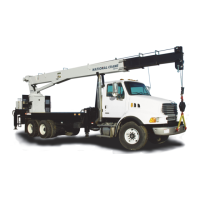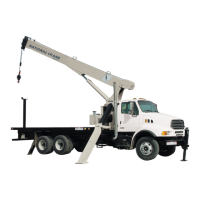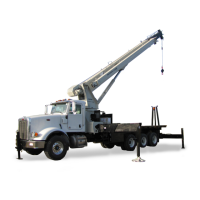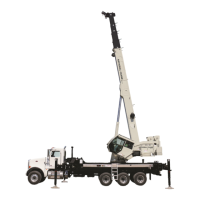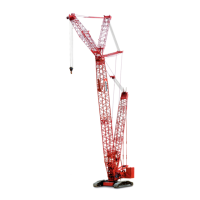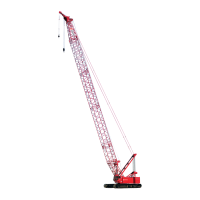3-10 Published 12-21-2012 Control # 103-06
OPERATING CONTROLS & PROCEDURES 1400A OPERATOR’S MANUAL
.
To start the high speed, depress the high speed switch and
operate the hoist lever on the armrest.
NOTE: Maximum Capacity with “BOS”
• One Part Line - 3000 lbs. (1361 kg)
• Two Part Line - 6000 lbs. (2722 kg)
• Three Part Line - 9000 lbs. (4082 kg)
• Maximum line speed on third layer - 240 FPM
(73 mpm), fourth layer - 265 FPM (81 mpm)
WORK SITE LOCATION
Select a location that is firm, level, and dry. Avoid uneven,
rocky or muddy terrain, steep grade or locations with
overhead obstructions. The outrigger stabilizers must be
supported on a firm level surface at the fully retracted,
mid-span, or fully extended positions. Avoid overhead power
lines.
Before Leaving the Truck Cab
• Position the truck so that the outriggers can be extended
with no obstructions.
• Position the truck transmission to neutral.
• Set the truck park brake. Wheel chocks may also be
required.
• Engage the power takeoff.
• Turn the truck cab switch to OFF.
Before Making the Lift
• Set the outriggers as described in the Crane Set-up
section in this manual.
• Program the RCL as specified in the RCL Operator’s
Manual which is located in the crane cab.
• Check all controls for proper operation. If any abnormal
operations are detected, the condition must be corrected
before continuing.
• Check the work area for electric power lines.
LOAD CHART
Your unit is designed to provide satisfactory service if it is not
loaded in excess of the maximum rated loads specified in the
load chart. Overloading can create safety hazards, cause
structural damage, and shorten the service life of the crane.
You must understand how to use the load charts located in
the crane cab. Make sure the load, the working area, and the
crane configuration are within the load limit specified in the
load chart.
NOTE: Load handling devices (hook blocks and slings) are
considered part of the load.
Using the Load Chart
The following list is a definition of terms needed when using
the load chart.
• Load Radius - The horizontal distance from the
centerline of rotation, before loading, to the center of the
vertical load line or block. This distance is slightly
greater with an unloaded boom due to deflection.
• Loaded Boom Angle - The loaded boom angle is the
angle between the first section boom and the horizontal
with the load. The loaded boom angle combined with the
boom length approximates the operating radius.
• Working Area - The area measured in a circular arc
above the center line of rotation to the suspended load.
If no decal is present the work area is 360°.
• Freely Suspended Load - The load hanging free with
no direct external force applied except by the loadline.
• Side Load - Horizontal side force applied to the lifted
load either on the ground or in the air.
• Boom Length - The length from boom pivot pin to the
boom nose. Decals on either side of the boom shows
when specific boom lengths are reached.
• Range Diagram - The range diagram (Figure 3-9)
shows the operating radius and height of the unloaded
boom nose at all boom lengths and angles. It should be
used as a guide to position unloaded loadline and to
determine to approximate height to which the load can
be lifted.
• Structural Limit Line - Is contained in the range
diagram (Figure 3-9). It shows the lowest angle the
unloaded boom can be placed at for all boom lengths.
Below this line the machine is structurally overloaded.
The load chart contains the lifting capacities of the crane in
all allowable lifting configurations. The information is
presented in three parts, one for outriggers fully retracted,
one for outriggers at mid point, and one for the outriggers
fully extended. Each part contains the load chart, range
diagram, and hoist data sheet. In the examples shown here,
the information for the outriggers fully extended is used.
CAUTION
If the high speed feature is run continuously or with an
overload, damage to the crane or truck could occur.
DANGER
Truck must be in neutral when starting engine from crane
cab to avoid sudden potential movement of truck.
Reference Only
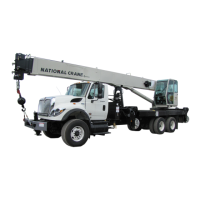
